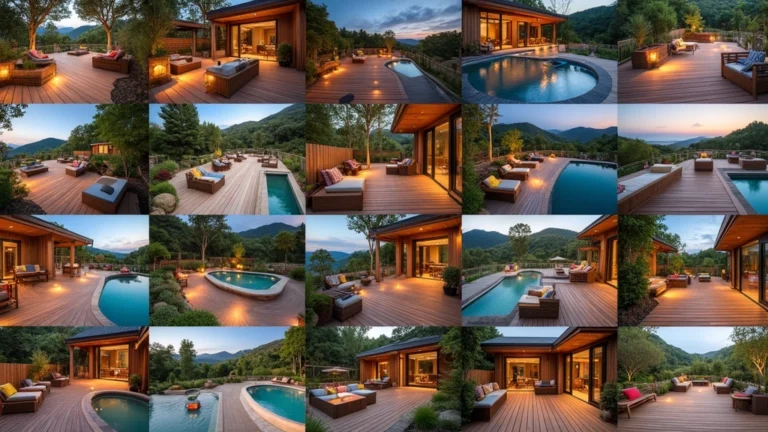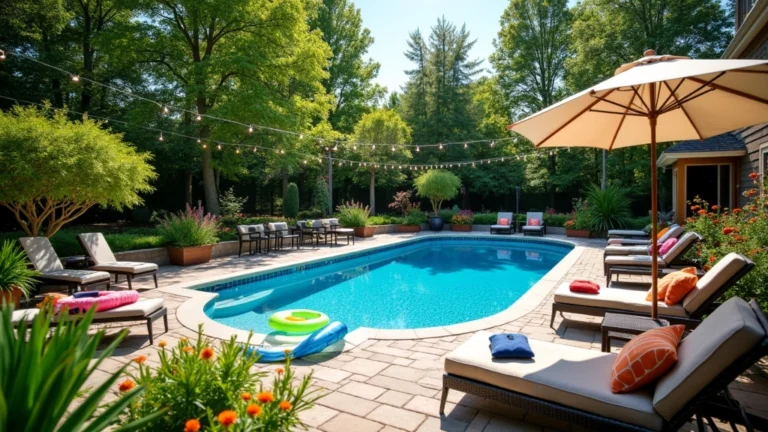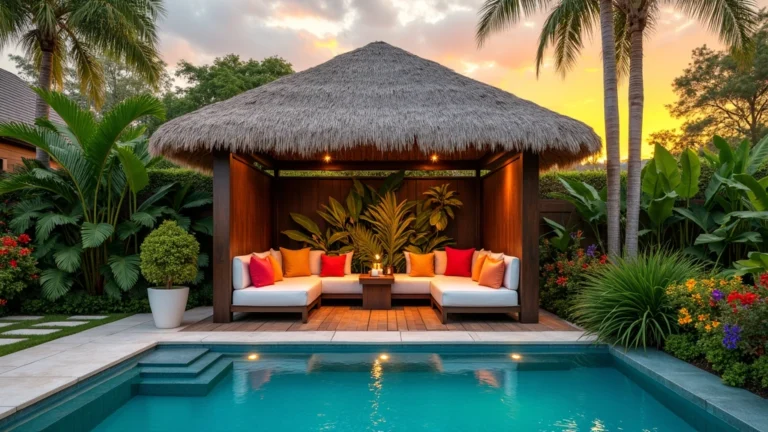23 Garden Ideas for Your Backyard: Sustainable Decor That Shines
Backyards aren’t just patches of green where the grass grows wild. They’re secret stages waiting for you to set the scene. Whether you’re sipping iced tea on a summer afternoon, hosting a barbecue, or sneaking away for five minutes of peace, your garden can transform from an ordinary outdoor spot into a sustainable oasis that feels like it belongs in a magazine. But here’s the thing—sustainability doesn’t mean giving up beauty or creativity. It’s about designing your space in a way that nurtures both you and the environment.
Below, I’ll walk you through 23 garden ideas that make your backyard look stunning while also treading lightly on the planet. Consider this your garden playbook, packed with practical tips, surprising stats, and just enough friendly advice to get your green thumb tingling.
1. Plant Native Species for Effortless Beauty
One of the simplest yet most impactful choices you can make is to plant native plants. These are species that naturally thrive in your region, meaning they require less water, less maintenance, and no chemical fertilizers to survive.
Did you know that according to the National Wildlife Federation, native plants can save up to 60% more water compared to non-native species? That’s huge when you think about summer water bills.
Personal story: When I swapped my thirsty rose bushes for native wildflowers, my backyard buzzed with life. Butterflies, bees, and hummingbirds showed up like I had just opened a five-star resort for pollinators. And the best part? I barely watered them after the first season.
2. Use Compost as Black Gold
Forget expensive fertilizers. Compost is nature’s way of recycling. By composting kitchen scraps (like coffee grounds, vegetable peels, and eggshells), you create nutrient-rich soil that your plants will thank you for.
According to the EPA, composting can reduce household waste by up to 30%, meaning less trash goes to landfills. Plus, when used in your garden, compost helps retain soil moisture, reducing your need for constant watering.
Think of compost as the espresso shot for your soil—it gives plants that little kick of energy they need to thrive.
3. Collect Rainwater Like a Pro
Why pay for water when the sky gives it away for free? Rainwater harvesting is both practical and eco-friendly. A single inch of rain on a 1,000-square-foot roof can yield over 600 gallons of water. That’s enough to keep your backyard lush for weeks.
Installing a rain barrel near your gutters takes little effort but makes a big difference. Plus, rainwater is free of chlorine and other chemicals found in tap water, making it healthier for your plants.
4. Build Raised Garden Beds from Reclaimed Wood
Raised garden beds aren’t just trendy—they’re efficient. They warm up faster in spring, drain well, and keep weeds at bay. To keep things sustainable, use reclaimed wood or recycled materials instead of buying new lumber.
Once I built a raised bed out of leftover wooden pallets. Not only did it save me money, but it also gave my backyard a rustic charm you can’t buy in a store. And yes, my tomatoes grew like they had something to prove.
5. Install Solar Garden Lights
Lighting can make or break the mood in your backyard. Instead of running extension cords and racking up your electricity bill, try solar-powered garden lights. They charge during the day and glow at night, creating a cozy, sustainable ambiance.
According to the International Energy Agency, solar power is the fastest-growing energy source globally. Why not bring a little of that progress to your backyard?
6. Create a Pollinator Paradise
Bees, butterflies, and birds aren’t just pretty visitors—they’re crucial to the ecosystem. You can encourage them to hang around by planting nectar-rich flowers, leaving patches of wild grass, and even setting up a bee hotel.
Fun fact: About one-third of the food we eat depends on pollinators. So when you create a pollinator-friendly garden, you’re indirectly helping stock your kitchen too.
7. Add a DIY Herb Spiral
An herb spiral is a vertical garden design that lets you grow herbs in layers, saving space and water. Different herbs thrive at different moisture levels, and the spiral design naturally accommodates that.
It’s a conversation starter, too. When friends visit and see a spiral of basil, rosemary, and mint climbing upward like a green tower of flavor, they’ll probably ask, “Did you really build that yourself?” And you can proudly nod.
8. Use Gravel or Mulch for Low-Maintenance Paths
Instead of laying down water-hungry grass everywhere, consider mulch or gravel pathways. They define your garden’s layout, reduce weed growth, and help with water retention.
The U.S. Geological Survey notes that mulching reduces evaporation by 25–50%, which means less watering for you. Think of mulch as your soil’s sunscreen—it shields it from harsh sun rays.
9. Add a Living Wall or Vertical Garden
If space is tight, go vertical. A living wall covered in greenery doesn’t just look spectacular—it also improves air quality and helps insulate your home if placed strategically.
Urban studies have shown that vertical gardens can lower surrounding air temperatures by up to 5°F, making your backyard more comfortable in summer.
10. Repurpose Everyday Items into Planters
Instead of buying new pots, repurpose what you already have. Old buckets, teapots, crates, or even a retired wheelbarrow can become quirky planters. Not only does this reduce waste, but it also adds a story to your garden décor.
When I used an old pair of boots as planters for succulents, neighbors thought it was a design statement. Truth be told, I just couldn’t throw them away.
11. Build a Wildlife-Friendly Pond
A small pond or water feature can transform your backyard into a wildlife hub. Frogs, dragonflies, and birds will flock to it. To keep it eco-friendly, avoid chemical cleaners and instead use natural pond plants like water lilies to filter the water.
Even a small 3-foot pond can support dozens of species and reduce backyard pests naturally by attracting mosquito-eating critters.
12. Grow Edible Landscaping
Who says landscaping has to be purely decorative? Edible landscaping combines beauty with function by incorporating fruit trees, berry bushes, and edible flowers into your design. Imagine strolling outside to grab a handful of blueberries instead of mowing another patch of lawn.
According to the FAO, over 800 million people worldwide practice urban agriculture. Why not join them and let your backyard double as your pantry?
13. Go for Drought-Tolerant Plants
If you live in a dry climate, water-thirsty plants can become a nightmare. Instead, choose drought-tolerant species like lavender, succulents, or ornamental grasses. They look stunning without demanding constant watering.
Plus, drought-resistant landscaping can reduce water usage by up to 70%, according to the EPA’s WaterSense program.
14. Use Natural Stone for Decor
Natural stone pathways, borders, and seating areas are timeless and sustainable. Unlike plastic décor that breaks down, stone lasts for decades with little maintenance. Plus, it weathers beautifully, blending with the landscape over time.
Think of stone as the jeans of garden design—always in style, durable, and easy to dress up or down.
15. Grow a Mini Orchard
If space allows, plant a couple of fruit trees. Not only do they provide shade, but they also yield fresh produce year after year. Choose varieties suited to your climate for best results.
According to the USDA, a mature apple tree can produce up to 300 apples per year. That’s plenty for pies, jams, and snacks straight off the branch.
16. Create an Outdoor Composting Station
If you want to take composting to the next level, dedicate a corner of your backyard to an outdoor composting station. Build bins from pallets or buy rotating compost tumblers.
Having a designated space keeps things tidy and makes it easier to manage organic waste consistently. It’s like having a secret factory that turns garbage into garden treasure.
17. Try Hugelkultur Beds
Hugelkultur is a German gardening method where you bury logs and branches under a raised bed. As the wood decomposes, it releases nutrients and holds water like a sponge.
This technique can reduce watering needs by up to 50% and create fertile soil for years. It’s like building a hidden underground buffet for your plants.
18. Incorporate Recycled Materials into Decor
From wine bottles turned into borders to tin cans as lanterns, using recycled materials for garden décor adds character while reducing waste.
Once, I lined a walkway with upside-down glass bottles. Not only did it sparkle when the sun hit it, but it also cost me nothing—just a few dinner parties with friends.
19. Build a Butterfly Garden
Planting milkweed, zinnias, and coneflowers can attract butterflies, turning your yard into a kaleidoscope of colors. Butterflies aren’t just pretty; they’re pollinators, too.
And here’s a bonus: a butterfly garden doubles as a stress-relief corner. Watching those delicate wings flutter feels like free therapy.
20. Install Drip Irrigation
Traditional sprinklers waste water through evaporation and runoff. A drip irrigation system delivers water directly to the plant roots, where it’s needed most.
According to the USDA, drip irrigation can reduce water usage by up to 50% compared to sprinklers. Plus, it keeps your foliage dry, reducing plant diseases.
21. Grow Vertical Food Gardens
Even if your backyard is small, you can grow plenty of food using vertical planters. Stack pots, use wall-mounted systems, or try pocket planters.
When I first tried a vertical strawberry planter, I felt like I had unlocked gardening cheat codes—suddenly, I was harvesting fruit from a wall.
22. Add a Fire Pit with Natural Materials
A fire pit made of stone or reclaimed brick creates a cozy gathering space. Avoid synthetic or treated materials, as they can release toxins when exposed to heat.
Not only does it add charm, but it also extends your backyard’s usability into chilly evenings. Marshmallows optional, but highly recommended.
23. Create Shade with Pergolas and Vines
Instead of relying on plastic umbrellas, build a wooden pergola and let vines like wisteria or grapevines climb over it. This creates natural shade while doubling as a stunning focal point.
According to climate studies, shaded areas can be 10–15°F cooler than open sun spots, making pergolas both beautiful and practical.
Conclusion
Your backyard doesn’t need to be a cookie-cutter lawn with a couple of chairs. With these 23 sustainable garden ideas, you can design a space that looks beautiful, saves resources, and supports local ecosystems. From planting natives and building herb spirals to setting up rain barrels and compost bins, every idea here adds a layer of personality and sustainability to your outdoor haven.
Think of your backyard as a canvas. Every choice—every plant, pathway, and light—adds brushstrokes to a masterpiece that reflects both your style and your values. And the best part? By going sustainable, you’re not just creating a backyard that shines today—you’re ensuring it keeps shining for years to come.


